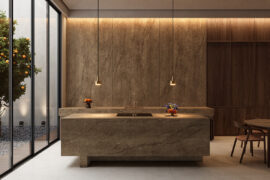Actions speak louder than words, as Herman Miller sets a new agenda for sustainability, advocating for the health of our oceans.

October 11th, 2021
In an outstanding and progressive initiative, Herman Miller is leading the way in sustainability practice through the incorporation of ocean-bound plastics in its products.
On September 1st Herman Miller announced that its entire portfolio of Aeron Chairs will contain ocean-bound plastics that, in real terms, is projected to annually save more than 150 tons of plastic from polluting our oceans.

Herman Miller’s Aeron chair.
Ocean-bound plastics will be utilised in the frame and tilt covers of the Aeron range and in the new Onyx Ultra Matte Aeron chair, where the process translates to 1.13 kilograms per chair of mismanaged plastic waste found near waterways. Overall, the total plastic diverted from oceans will equal approximately 15 million single-use plastic water bottles. Instead of simply talking about being a sustainable company, Herman Miller is again actually putting words into actions.
As a company, Herman Miller is committed to 50 per cent recycled content in all materials by 2030 and through this program of utilising ocean-bound plastics, it is well on the way to meet this target. This initiative is part of Herman Miller’s membership in NextWave Plastics, a collaborative consortium of multinational technology and consumer brands that have gathered together to help decrease the volume of plastic litter that enters our oceans.
Sustainability is integral in design today and practitioners from three of Australia’s top architecture and design firms have made comment on Herman Miller’s latest commitment to our environment.
Lucy Sutton, Associate Director, Bates Smart, “I think it’s great that Herman Miller is taking steps to incorporate circularity into their products. We are constantly looking at how we can take a more sustainable approach to design. Thinking about the whole lifecycle of products is a big part of that. Like the Herman Miller initiative, we are changing the way we approach things,” says Sutton. “We have always reviewed products under the lens of aesthetics, budget, maintenance and durability, and now sustainability is a key metric that is part of that process for us. A product that supports positive climate change and has a good environmental footprint by reducing waste and carbon production—well, that ticks a lot of boxes from our perspective.”

Lucy Sutton, Associate Director, Bates Smart. Photography by Andrew Goldie.
Maggie Lum, Associate and Team Leader, Smart Design Studio (SDS) commented, “I think it’s something you would expect from a well-established and highly respected brand like Herman Miller. More brands need to develop and provide sustainable products so that it is easier for designers to find and specify products, ranging from furniture to building products. It makes me feel better if I’m specifying a product with recycled content that it is also recyclable, but often these products are essential for satisfying the criteria in environmental certification programs.”

Maggie Lum, Associate and Team Leader, Smart Design Studio (SDS).
Considering Smart Design Studio’s approach to sustainability Lum reflected, “Everything that we do now needs to consider sustainability. We try to specify products with low embedded carbon such as low carbon concrete, and energy efficient systems such those we have recently installed in our own studio. We’ve eliminated air conditioning in our studio, except in the entry foyer and boardroom. The main studio space has an under floor hydronic system for heating and cooling, ceiling fans and natural ventilation facilitated by automated windows and blinds. There are also 260 PV panels on the roof so that we generate all our own power. The building itself is an adaptive re-use of an industrial warehouse, where we have kept all of the great parts such as the sawtooth roof structure which provides natural light, and replaced the parts that were detracting.”

The Aeron Chair is Herman Miller’s top selling seating solution and has received a plethora of awards since it’s introduction. Designed by Bill Stumpf and Don Chadwick in 1994, and remastered in 2016, it is outstanding in both ergonomics and material innovation and will once more set a precedent for design.
Specifying product that is world class but also meets sustainable process is uppermost in the minds of architects and designers today and Simon Topliss, Principal, Warren and Mahoney stated, “I think Herman Miller’s association with NextWave Plastics is a great initiative and terrific stance for such a high design item to be taking.”

Simon Topliss, Principal, Warren and Mahoney.
“We employ a thorough, principle-based sustainability approach, and the use of ocean-bound plastics in the manufacture of the Aeron Onyx chair keys directly into these.” he commented. “In making design decisions we try, wherever possible, to select products that reconcile with our processes, but that isn’t always straight forward. We’re obviously really focused on the protection of water and waterways and looking after Country. So, if you can tie all these considerations into a really elegant solution, then you’re definitely on to something.”
Topliss continues, “It’s great to see a positive environmental and economic outcome for the local communities where the actual plastics are being collected. We’re talking about a product that educates at a brand level and has direct impact at a manufacturing level.”

“All these initiatives, in a sense, they’re really small but they’re all opening little doors, and that’s what we need to do get the whole audience inside the tent.” he concluded.
With a commitment to sustainability through the incorporation of ocean-bound plastics into the Aeron range of chairs Herman Miller is taking the future into its own hands and delivering a product that is not only an exemplar design but future focused in materiality.
And with a last word from Lum who reiterated, “It’s just about being responsible. The amount of plastic in the environment is at catastrophic levels, so Herman Miller’s commitment to reducing the amount of plastic going into the oceans is very encouraging and should encourage other manufacturers to also take on that responsibility.”

Herman Miller
hermanmiller.com
INDESIGN is on instagram
Follow @indesignlive
A searchable and comprehensive guide for specifying leading products and their suppliers
Keep up to date with the latest and greatest from our industry BFF's!

London-based design duo Raw Edges have joined forces with Established & Sons and Tongue & Groove to introduce Wall to Wall – a hand-stained, “living collection” that transforms parquet flooring into a canvas of colour, pattern, and possibility.

For Aidan Mawhinney, the secret ingredient to Living Edge’s success “comes down to people, product and place.” As the brand celebrates a significant 25-year milestone, it’s that commitment to authentic, sustainable design – and the people behind it all – that continues to anchor its legacy.

Cosentino introduces Éclos®, a new mineral surface brand featuring zero crystalline silica, high recycled content and Inlayr® technology that brings 3D layered realism to design.

In Auckland, Wingates designs a new headquarters for a specialist investment firm focused on future growth, biophilia and collaborative work.

At the NGV’s Making Good: Redesigning the Everyday, design becomes a force for repair. From algae-based vinyl to mycelium earplugs, the exhibition proves that rethinking the ordinary can reshape our collective future.
The internet never sleeps! Here's the stuff you might have missed

From Valmont to GEYER VALMONT, Marcel Zalloua walks us through some of the milestones of what has been a fruitful, busy career in design.

Having recently attended the Symposium as the Murcutt Pin-holder, Sydney-based architect Jamileh Jahangiri reflects on the importance of the gathering.

Held in a private Melbourne residence, Fletcher Arts’ annual exhibition unites over 30 Australian artists and designers in a setting where art meets architecture.